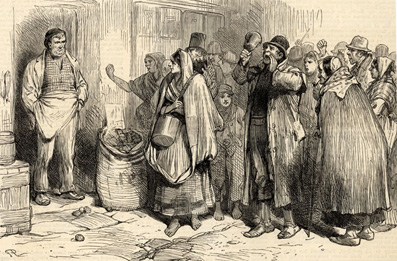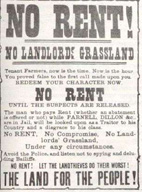Irish Land League

After the Great Famine of 1845-50, Irish agriculture
recovered steadily – until the harvest failed again in 1877,
at the same time as North American agricultural products flooded
the market. The leases, which had to be paid to English landowners
and which could be endured during the prosperous years, were not
lowered, however, and since they were at the same time a kind of
symbol of class society, they also became a symbol of economic misery.
This provided a brilliant opportunity for the Irish nationalists
of the cities, for whom the English landowners represented the foreign
government. Until then, they had seldom cared about rural problems,
but now a number of people within the Irish Republican Brotherhood
began to build an alliance between the urban nationalists and the
economically distressed peasants.
The alliance was based on ”constructive disagreement” and
consisted of centrally located members of the Irish party in the
British Parliament, the Republican Brotherhood and a newly built
organization that spread rapidly, especially in Western Ireland,
and relied not only on the tenants themselves but also on the support
of parish priests. and retailers who relied on them: the Irish Land
League.
The tactics were four:
The most famous was to organize boycotts – the word comes from
the social isolation that the Land League imposed on the English
estate manager John Boycott for his brutal methods and which was
also applied against unsympathetic peasants. Illustration see above.
The most effective was to invent so much hassle for landowners who
wanted to collect the rents – to pay in small installments,
to appeal to courts, to block the roads, etc. – that the collection
became so expensive that the landowners voluntarily agreed to a reduction.
A supporting tactic was, with the help of the jury system in the
British courts, to have as many evictions as possible ruled illegal
or at least to give the evicted tenant damages for his improvements
made, that the penalty was ineffective
Ultimately, the Land League was able to provide support to evicted
farmers thanks to fundraisers among the Irish in the United States.
The purpose of the campaign was not always clear. There was a tension
between those who wanted low secure leases, ”the three F’s” -
Fixed tenure, Fair rents and Free sale, i.e the right of possession,
decent leases and the lessee’s right to sell their lease, and
those who considered that only land reform and farmers’ property
rights would help. The tension was not least due to the fact that
many tenants were quite wealthy and in turn leased out land. However,
the movement managed to allow this disagreement to remain ”constructive”,
i.e to contribute to a broadened base that did not interfere with
the movement’s practical work.
While local justice in Western Ireland was increasingly taken over
by the Land League, English-owned estates became increasingly worthless.
As early as 1881, the government gave up, after having tried in vain
to stop the movement by arresting its leaders. The three F’s
were written into the law, and the estates began to be bought up
by the state to be sold cheaply in small pieces to the tenants.
The Irish ”land war” can be seen as a precursor to 20th
century peasant movements for land reform. Its most lasting result,
however, was that from now on the peasants became a backbone of the
Irish national movement, which for the first time had a clear victory
to point to. Plus, of course, the immediate misery was remedied.

Reading
Paul Bew: Land and the national question
in Ireland 1858-1882, Gill and Macmillan 1978
|



